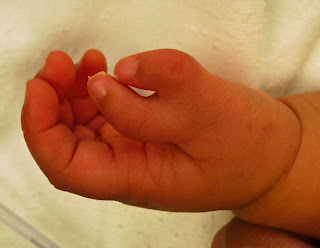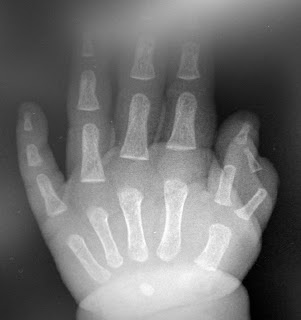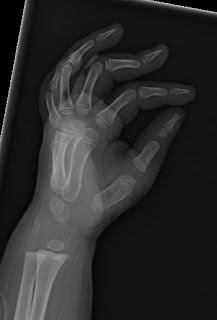Radial polydactyly is also called split thumbor thumb duplication. Or, an extra thumb if we really want to keep it simple. Extra thumbs all share some similarities but each is really unique.
How most patients with radial polydactyly are similar
- Both thumbs are smaller than the “normal” thumb should be.
- Many extra thumbs have decreased motion. Fortunately, decreased motion is not a terribly big deal for function as the thumb can be great for function even with limited flexibility. It is more important that the thumb be well aligned and stable.
- Most thumbs are usable even though there is an extra digit. However, the extra thumb is often in the way, might limit use of the better thumb, and obviously creates a social issue for the child (with possible mental health impacts).
How patients with radial polydactyly can be different
- Some extra thumbs are pretty straight and some are really crooked ( really “z” shaped). This fact is, to me, the most important difference and the one that affects surgical technique and surgical outcome most. It is also the reason that more than one surgery might be necessary.
- Some thumbs have really pretty normal underlying tendons and joints whereas other thumbs have abnormal tissues. This affects motion and may play a role in recurrence of deformity.
- Sometimes the thumb is positioned right where it should be- a position to maximize holding big objects and pinching against index finger. Sometimes the thumb is more in the plane of the fingers, thus making pinch more challenging.
- Some extra thumbs are small and only have a single bone whereas others have 3 or more bones, extra muscles, etc.
The following is a case of an extra thumb treated at a young age with a result that has made the family really happy. The radial polydactyly surgery was somewhat complicated with excision of the extra, outer thumb and reconstruction of the inner thumb. That reconstruction included stabilizing the main joint, cutting and angling the bone, and realigning the tendon.
Some of our research has been on the topic of appearance after the reconstruction of radial polydactyly.
http://www.ncbi.nlm.nih.gov/pubmed/18929199 This paper reviews the appearance outcome from a number of patients that we treated with surgery and concludes that the type of radial polydactyly (i.e., based on the bony appearance before surgery), the angulation after surgery, and the nail itself affect satisfaction with surgery.
Currently, the patient uses the thumb well, has a stable thumb, and has no pain. The size is good and not noticeably smaller than the other thumb. However, the thumb is not straight. At this point, the family is not concerned with the deformity. Yet, I believe it is something that can be effectively corrected as the child gets a bit older.
The hand doubles in size from birth until 2 years of age and then almost doubles again at an adult size. As the thumb gets larger, a correction is easier to accomplish and can be done more precisely. I believe that this patient will benefit from an osteotomy (or cutting) of the bone to straighten the thumb. I continue to follow patients on a yearly basis and the family and I will continue to discuss this decision. I have no intention of “talking” the family into a surgery but will make them aware of the option and what an osteotomy surgery would require. Specifically, it would require an outpatient surgery, require less than1.5 hours of surgery time in most cases, and require pinning of the bone(s) for about 5 weeks. We may have to work on the soft tissues again as well. The patient’s thumb and hand would be casted during those first 5 weeks and possible splinted later.
 |
| Radial polydactyly before surgery. Note that both thumbs are crooked. We reconstructed the inner thumb and removed the outer thumb. |
 |
| X-ray of radial polydactyly |
 |
| 1 year after radial polydactyly surgery. |
 |
| Another view 1- year after surgery to reconstruct radial polydactyly. Note that the thumb is crooked. |
 |
| x-ray after radial polydactyly reconstruction |
 |
| x-ray after radial polydactyly reconstruction |
Thank you for writing this! My daughter was born with this condition and we are soon going to be adventuring into the corrective surgery. It is so helpful to see the before and after results and it gives me some peace of mind.
Thanks for your comment and good luck!
What age would you recommend surgery be started?
Lee, thanks for the question. The best age for treatment is really a tough question because a number of factors have to be considered including the type of extra thumb, the functioning of the thumb in general, other medical issues, etc. However, having shared those factors, I typically operate between 18 and 24 months. While surgery can be done earlier, allowing time for the thumb to grow is helpful at surgery.
Thank you for this post. My son was born with similar condition. It's good to see the before and after pictures. Now, we know what to expect. Are there any ways to fix the crooked thumb? I wish there are more postings about this condition on the internet. We live in NYC. Ideally, I'd like to go to a doctor who has as much experience and knowledge as you do. I have some questions for you. He is only 1 week old now. When will be the best age to start seeing a doctor? Do you know any hospitals or surgeons specialized in this procedure in NYC or east coast?
Thank you!
Thank you for the question. Hopefully the posts in this blog and some of the other questions will be helpful. I believe that seeing the doctor in the next 2-3 months is perfectly fine. Then you can discuss options and timing which are based on a number of factors. Good luck.
Hi Dr Goldfarb,
Can you please let us know what type of duplicate thumb this patient had based on the Wassel classification?
Hello Kaohli,
I presume you are asking about the child in my post. That is a Wassel Type 4 thumb (two proximal and distal phalanges). There is a big variety in such kids meaning that every Type 4 is not the same- some are much more challenging to treat. I hope that helps.